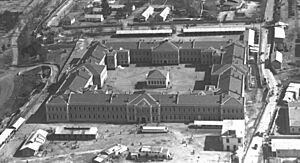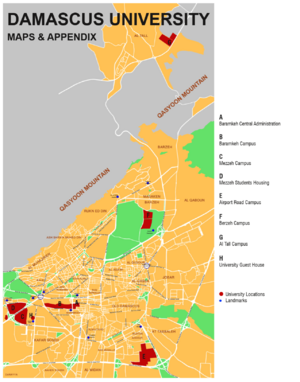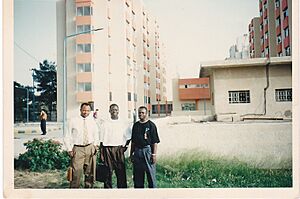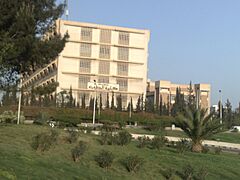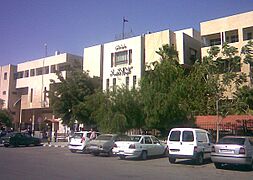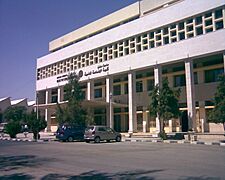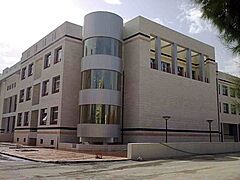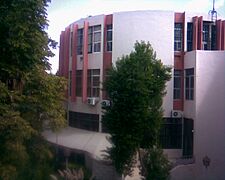Damascus University facts for kids
|
جامعة دمشق
|
|
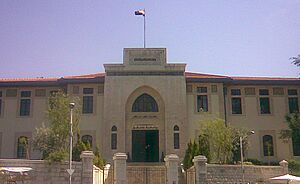
The main building of Damascus University in the Baramkeh neighborhood.
|
|
|
Former names
|
Syrian University (1923–1958) |
|---|---|
| Motto | وَقُل رَّبِّ زِدْنِي عِلْمًا (Quran, 20:114) |
|
Motto in English
|
And say: My Lord, increase me in knowledge. |
| Type | Public |
| Established | 1923 (Medical School in 1903) |
|
Academic affiliation
|
|
| President | Dr. Mustafa Saem Aldaher |
|
Administrative staff
|
2,697 |
| Students | 182,503 |
| Undergraduates | 169,067 |
| Postgraduates | 13,436 |
| 1,211 | |
|
Other students
|
9,289 international students |
| Location | , |
| Campus | Urban |
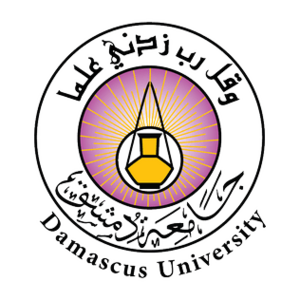 |
|
Damascus University (in Arabic: جامعة دمشق) is the oldest and largest university in Syria. It is located in the capital city, Damascus, and has smaller campuses in other Syrian cities.
The university was officially created in 1923 when the Medical School (started in 1903) and the Institute of Law (started in 1913) joined together. At first, it was called the Syrian University. It was renamed Damascus University in 1958.
Before the Syrian civil war started in 2011, Damascus University was considered one of the top universities in the Arab World. It has many different schools, called faculties, where students can study subjects from medicine to art. It also has a special school for teaching the Arabic language to people from other countries.
Contents
History of the University
The story of Damascus University began over 100 years ago.
- 1903: A School of Medicine opened in Damascus. This was the very beginning of the university. It taught medicine and pharmacy in the Turkish.
- 1913: A Law School opened in Beirut. Most of its teachers were Arab, and classes were taught in Arabic.
- 1919: After World War I, the School of Medicine and the School of Law were both opened in Damascus.
- 1923: The two schools officially joined to become the Syrian University.
- 1946: The university began to grow, adding more faculties for different subjects.
- 1958: A new university was started in the city of Aleppo. To avoid confusion, the Syrian University was renamed Damascus University.
Over the years, more schools were added, like the College of Fine Arts in 1972. The university has continued to grow and offer more subjects for students to study.
What You Can Study
Damascus University offers many programs for students. Students can earn a bachelor's degree, which usually takes four to six years. They can also continue their studies to get a master's degree or a Ph.D. (doctorate degree).
Schools and Faculties
The university is divided into different schools, called faculties, for each subject area. Some of them include:
- Medicine: Started in 1903, this is one of the oldest parts of the university.
- Dentistry: Started in 1921.
- Pharmacy: Started in 1903 with the medical school.
- Law: Started in 1913.
- Arts and Humanities: This school for subjects like history and languages opened in 1928.
- Engineering: Includes schools for civil, mechanical, electrical, and IT engineering.
- Sciences: For subjects like biology, chemistry, and physics.
- Economics: For studying business and money.
- Fine Arts: For students who want to study painting, sculpture, and other art forms.
- Political Science: For studying government and how countries work together.
Special Institutes
The university also has special centers for advanced learning. One of the most famous is the Arabic Language Institute. It is known as one of the best places in the world for people who don't speak Arabic to come and learn the language.
There are also technical institutes where students can get a two-year diploma in fields like business, computer science, and medicine.
Campus and Facilities
University Library
The University of Damascus Library started in 1903. It is a large library with over 169,000 books and thousands of magazines and journals for students and teachers to use for their studies.
University Hospitals
To help train its medical students, the university runs eight hospitals in Damascus. Medical students get hands-on experience by working with real patients in these hospitals, which include a children's hospital and a heart surgery hospital.
University Logo
The logo of Damascus University is a lamp. The lamp is a symbol of knowledge and learning. It shines a light on science and discovery.
Above the lamp is a phrase from the Quran, which means, "say oh my Lord, increase me in knowledge." This is the university's motto, showing its goal to always search for more knowledge.
Famous Graduates
Many famous people have graduated from Damascus University. They have become leaders, artists, scientists, and writers. Here are a few of them:
- Mahmoud Abbas – The President of the state of Palestine.
- Khaled al-Asaad – An archaeologist who was in charge of the ancient city of Palmyra.
- Nizar Qabbani – A famous Syrian poet and writer.
- Moustapha Akkad – A film producer and director known for movies made in Hollywood.
- Dina Katabi – A professor at MIT in the United States who works on wireless computer technology.
- Ali Farzat – A well-known cartoonist and painter.
- Ghada al-Samman – A Syrian writer and novelist.
- Bashar al-Assad – The former President of Syria.
Gallery
See also
 In Spanish: Universidad de Damasco para niños
In Spanish: Universidad de Damasco para niños
- List of Islamic educational institutions



